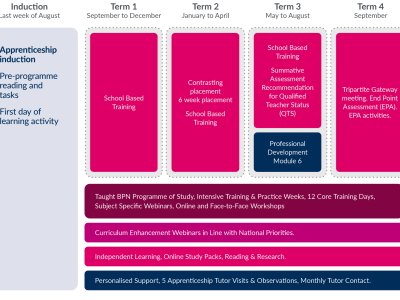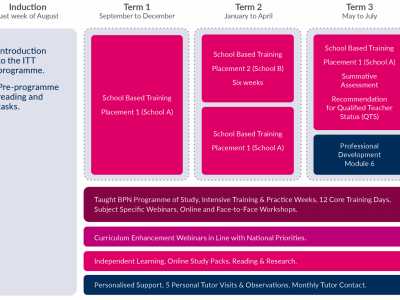SCITT vs PGCE
As a graduate considering a career in teaching, you've probably been exploring different training routes such as School-Centred Initial Teacher Training (SCITT) programmes (like the Postgraduate Teacher Apprenticeship or Fee-funded ITT) and the university-based postgraduate certificate in education (PGCE).
Both options have their differences, so how do you decide which one is best for you? This article will compare SCITT and PGCE to assist you in making the right choice for your career.
School-Centred Initial Teacher Training (SCITT)
What is School-Centred Initial Teacher Training (SCITT)
A School Centred Initial Teacher Training (SCITT) course allows you to get hands on, practical experience within the classroom therefore providing you with the tools, experience and knowledge to becoming a fully qualified teacher. Partnering with a network of local schools, Best Practice Network offers placements designed to help trainees achieve qualified teacher status (QTS).
From day one, you'll collaborate with a partner school, delivering lessons in your chosen subject while being integrated as a staff member among teaching professionals. If you've come across School Direct or Teach First, you'll notice similarities with SCITT.
Throughout the SCITT course, you'll also have the opportunity to work in a contrasting placement school, experiencing first hand the differences between the two environments. This provides an excellent opportunity to enhance your adaptability to different teaching settings, with the majority of your year spent within a school environment.
Best Practice Network offers two SCITT courses:
What role do mentors play?
With Best Practice Network, you'll have the support of a network of experienced teachers who will act as mentors for you and your fellow trainees. These mentors, who have likely completed a SCITT or PGCE course themselves, are equipped to share their knowledge and experiences, helping you improve as a teacher and develop the resilience needed for your Early Career Framework (ECF) induction.
What qualification do I receive when completing SCITT?
Opting for school-based teacher training doesn’t mean missing out on essential qualifications. All SCITT courses, including those run by Best Practice Network, provide qualified teacher status (QTS), which is necessary for teaching in schools in England and Wales.
PGCE certification is not a requirement to work in schools in England and Wales and is an additional cost (which cannot be funded through the levy for those following the Teacher Apprenticeship route).
How do I apply for School-Centred Initial Teacher Training (SCITT) such as the Postgraduate Teacher Apprenticeship or Fee-funded ITT?
If you've decided that a hands-on and practical approach to teacher training is for you, you can apply
What is the application process like?
You can apply directly through our website below. After an initial check, we will then contact you to arrange an interview. Once a successful interview has been completed and you have accepted a place to train to teach with BPN, we will then search for a school placement for you (if you do not already have a school that is willing to support your training).
What specialisms and subjects do you offer?
With Best Practice Network, you can specialise in primary, primary SEND or secondary teaching. You can further specialise in specific age groups (primary) or subjects (secondary). You can see all of the specialisms in the box below:
Which SCITT route is best for me?
We have two SCITT routes available: the Postgraduate Teacher Apprenticeship and Fee-funded Initial Teacher Training (ITT).
Both programmes are school-centred in that the majority of your training will occur in school as you learn on the job. However, there are key differences when it comes to funding and salary. You can compare the two programmes by looking at the respective programme structures below.
Teacher Apprenticeship |
Fee-Funded |
|
|---|---|---|
Secondary -
|
Available subjects: English, Maths, Chemistry, Physics, Biology, Computing, Geography, French and Spanish. | Available subjects: English, Maths, Chemistry, Physics, Biology, Computing, Geography, French and Spanish. |
Secondary -
|
Available subjects: English, Maths, Chemistry, Physics, Biology, Computing, Geography, French and Spanish. | Available subjects: English, Maths, Chemistry, Physics, Biology, Computing, Geography, French and Spanish. |
Entry requirements |
Bachelors Degree (2:2 or above or equivalent) GCSE grade 4/C or above in English and maths |
Bachelors Degree (2:2 or above or equivalent) GCSE grade 4/C or above in English and maths |
Fee |
£9,000 - funded by Apprenticeship Levy or co-funded by gov for non-levy payers. | £8,500 - trainee funded (Student Finance available) |
Grants, bursaries and scholarships |
Grants of up to £28,000 are available to contribute to trainee secondary teacher salaries depending on subject. | Bursaries of up to £27,000 are available for trainee secondary teachers depending on subject. Scholarships of up to £29,000 are also available depending on subject. |
Salaried |
Yes - employed in school on unqualified teacher pay scale. | N/A |
School Placement |
34 weeks in your employing school plus 6 weeks in a contrasting school (School B) | 32 weeks in School A plus 6 weeks in a contrasting school (School B) |
Learn More ➡️ |
Postgraduate Teacher Apprenticeship |
Fee-Funded ITT |



